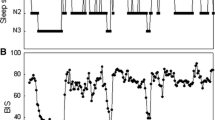Abstract
Objectives.Inadvertent sleep episodes are a recognizedcomplication of sleep deprivation. Although such events can be lifethreatening, no system currently exists to detect and prevent sleeponset. Because sleep shares electroencephalographic similarities withthe anesthetized state, we hypothesized that the BIS monitor, acurrently available EEG-based monitor of anesthetic depth, would detectthe onset of physiologic sleep. To test our hypothesis, we monitoredvolunteers during the transition from waking to sleep. Methods.Non-medicated volunteers were asked to lie down in a dark room for30-minutes and fall asleep while attached to a BIS monitor locatedoutside the room. A laptop computer was used to generate an audio toneinside the room. Speaker volume was adjusted to the lowest leveldetectable by the awake subject. Testing was begun by activating acomputer to play a tone at random intervals. The subject was instructedto click a mouse connected to the computer upon hearing the tone toverify wakefulness. The session was terminated upon loss of response tothree consecutive tones or after 30 minutes. Subjects were questionedafterwards regarding their perceptions of sleep during testing.Results.11 out of 28 self-described good sleepers could notsleep under testing conditions. BIS values for the remaining 17 fellfrom 96.4 ± 2.1 to 86.5 ± 0.79 (p< 0.01) uponsleep onset. All subjects responded to audio stimuli at BIS values>90, and were asleep either by subjective or objective report at BISvalues <80. Three subjects retained the mouse-click response despitelow BIS scores and subjective descriptions of sleep. Conclusion.Although variability in the BIS value marking sleep onset was noted,the BIS monitor detected all episodes of sleep onset in our testingregimen. We conclude that a threshold BIS value can be defined to allowthe BIS monitor to detect sleep onset.
Similar content being viewed by others
REFERENCES
U.S. Nuclear Regulatory Commission. Investigation into the March 28, 1979 Three Mile Island Accident by the Office of Inspection and Enforcement (Investment Report no. 50-320/j79-10, July 1979. NTIS NUREG-0600
Report of the Presidential Commission on the Space Shuttle Challenger Accident, Washington DC, US Government Printing Office 1986, vol II, Appendix G
Pack AI, Pack AM, Rodgman E, Cucchiara A, Dinges DF, Schwab CW. Characteristics of crashes attributed to the driver having fallen asleep. Accid Anal and Prev 1995; 27: 769-775
Findley LJ, Unverzagt ME, Suratt PM. Automobile accidents involving patients with obstructive sleep apnea. Am Rev Respir Dis 1988; 138: 337-340
National Sleep Foundation 2001 Sleep in America Poll. National Sleep Foundation, http://206.215.227.10/nsf/ publications/2001poll.html
Johansen JW, Sebel PS. Development and clinical application of electroencephalographic bispectrum monitoring. Anesthesiology 2000; 93: 1336-1344
Rampil IJ. A primer for EEG signal processing in anesthesia. Anesthesiology 1998; 89: 980-1002
Steriade M. Corticothalamic resonance, states of vigilance and mentation. Neurosci 2000; 101: 243-276
Sleigh JW, Andrzejowski J, Steyn-Ross A, et al. The bispectral index: A measure of depth of sleep? Anesth Analg 1999; 88: 659-661
Contreras D, Destexhe A, Sejnowski TJ, Steriade M. Control of spatiotemporal coherence of a thalamic oscillation by corticothalamic feedback. Science 1996; 274: 771-774
Instruction manual, A2000 BIS monitor. Aspect Medical Systems, Natick MA.
Mitler MM, Carskadon MA, Czeisler CA, Dement WC, Dinges DF, Graeber RC. Catastrophes, sleep, and public policy: Consensus report. Sleep 1988; 11: 100-109
Horstmann S, Hess CW, Bassetti C, Gugger M, Mathis J. Sleepiness-related accidents in sleep apnea patients. Sleep 2000; 23: 383-389
Kaplan RF, Loparo KA. U.S. Patent #5,813,993, Alertness and drowsiness detection and tracking system. Sep 1998
Hobson JA, Mamelak A, Helfand R, Lavie P. Electronic sleep monitor headgear. U.S. Patent#5,813,993, Jun 1989
Miller AJ. Automotive driving condition alarm system. U.S. Patent#4,492,952, Jan 1985
Steriade M. Brain electrical activity and sensory processing during waking and sleep states. In: Kryger MH, Roth T, Dement WC, eds., Principles and Practice of Sleep Medicine, 2nd edn. Philadelphia: WB Saunders 1994; 105-24
Spinweber CL, Johnson LC, Chin LA. Disqualified and qualified poor sleepers: Subjective and objective variables. Health Psychol 1985; 4: 569-578
Author information
Authors and Affiliations
Rights and permissions
About this article
Cite this article
Tung, A., Lynch, J.P. & Roizen, M.F. Use of the BIS Monitor to Detect Onset of Naturally Occurring Sleep. J Clin Monit Comput 17, 37–42 (2002). https://doi.org/10.1023/A:1015404803637
Issue Date:
DOI: https://doi.org/10.1023/A:1015404803637




